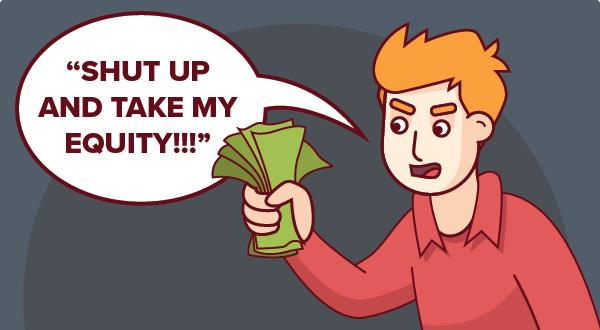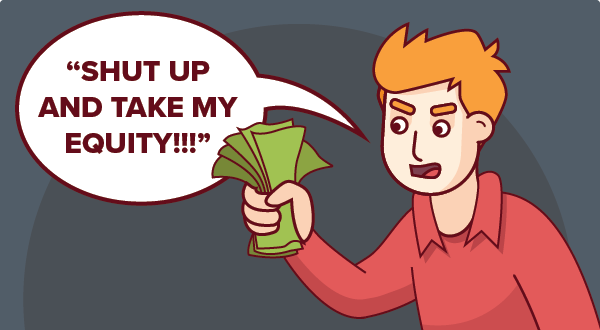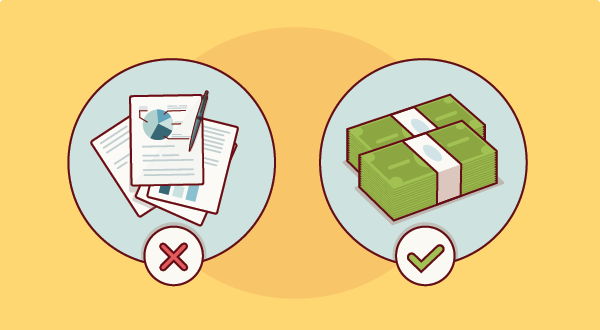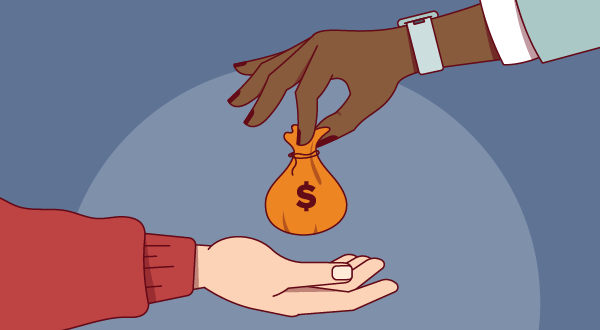The Startups Team

Welcome to Phase Four of a four-part Splitting Equity Series. If you missed it, start your journey here: Introduction - Early Startup Equity — Getting it Right before continuing on if you haven’t already, and go in order from there.
Phase One - Startup Equity - Avoiding Early Mistakes
Phase Two - How Startup Equity Works
Phase Three - How to Split Equity
Phase Four - Part 1 - Equity Management
Part 2 - Recovering Startup Equity ( ←YOU ARE HERE 😀)
Let's do this!
When it comes to startup equity distribution, giving away a startup's equity is easy. How much equity do we get back? Well, that's a different story altogether!

An "equity clawback" is designed for early-stage startups to essentially reverse an equity grant based on a number of provisions. Most employees (OK, all of them) dread the idea of giving back their incentive stock options, and therefore, an Equity Clawback tends to be the most contentious provision of all.
They don’t even sound friendly.
Equity Clawback Provisions are likely going to be the single most important part of how most startups manage their stock options long-term and can have a major impact on the ownership of the startup. We'll have other mechanisms like a four-year vesting schedule or a one-year cliff, but eventually, we'll need an equity clawback.
Equity Clawback Provisions
For what it's worth most outside investors (starting with our first angel investor) will likely bake these into our ownership documents like our Operating Agreement prior to making an investment anyway. The versions of these provisions will vary depending on how evolved our business gets — and how quickly our post-money valuation skyrockets!
Within our team, though, we most definitely need to make an informed decision on these provisions before we get too far along or the discussion will turn into one person defending their particular situation versus the entire group agreeing on a hypothetical future, and it costs everyone.
Stock Clawback Scenarios Founders Should Discuss
Long before we ship their first offer letter, startups and small businesses should be having a discussion amongst the Founders (or early employees) around what conditions would likely constitute a termination.
Someone is terminated for cause. “For cause” means someone was fired for a valid reason – they did something materially wrong. That could range from job performance to criminal activity but would be stated as “out of bounds” in the Operating Agreement (for members), the Stock Agreement (for participants), or even the Employment Agreement (for everyone). Being terminated for cause typically invokes a much harsher Equity Clawback penalty and in some cases can lead to the rescission of benefits altogether.
Someone is terminated without cause. “Without cause” means the member didn’t deliberately do something wrong. This could be a reduction in staff (“We ran out of money and we need to make a salary cut”) or someone simply quitting. In this case, we may have a lighter clawback or none at all. These tend to be a departure on mutually agreed upon circumstances, or at the very least, ones that do no deliberate harm to the company.
Exercise Period expires. In the event of an “exercise window” expiring, the stock returns to the Cap Table. Typically, this happens if a Stock Option is not exercised within the allotted time at the available "Strike Price." In this case, it may not matter whether there was a termination for cause (such as if it was an agreement with a contractor or advisor who is not employed by the company) but may simply be a matter of how the exercise window itself is provisioned and elapses.
Based on how the clawback is invoked, there will be a number of different outcomes.
How to Handle the Equity Clawback
Now that we know we are looking at two main scenarios for clawbacks — termination for cause and without cause — the million dollar question becomes, “How do we actually handle each of these scenarios as it relates to a clawback?”
Darth Vader and Luke Skywalker Debate an Equity Clawback
Let’s take a look at two ends of the spectrum and decide as a team which way we want to lean. Instead of presenting the lawyer’s perspective, let’s take a look at how Darth Vader and Luke Skywalker view clawbacks in their respective organizations. This will illustrate the difference in how Founders think about their approach on either end of the “dark side” and “light side” spectrum.

Someone Leaves for Cause
Darth Vader (Stern) “You get nothing”
The employees failed at their job. We had a contract to perform in exchange for services and they failed to meet their performance requirements. They deserve nothing. (initiate force grip!)Luke Skywalker (Friendly) “You get what you earned”
While things with some employees may not work out, they deserve at least some token for their commitment toward the company, even if it’s a minor future payout.
Someone Leaves Without Cause
VADER “You keep a little stock”
They may get a token amount of stock but the reality is they are no longer part of this enterprise and we refuse to pay penance while they drift hopelessly in space. (shake fist menacingly)LUKE “You keep all your stock”
We value their commitment to our organization and the time served should be well-rewarded now and in the future. They should be able to keep all of the stock they’ve vested without penalty and enjoy the benefits of any future compensation as a result.
Feeling toward Dormant Equity
VADER “Only paid if you stay until exit”
Only the material and active participants in the future of this Empire should reap its rewards. Anyone else that is not there when we finally conquer the galaxy will not be recognized with the spoils of our victory. (tents fingers)LUKE “You get paid forever”
Our journey will be long and challenging and different allies will help us along the way. We need to recognize that each contribution, regardless if that member is currently with us, should be rewarded in the long term through equity compensation.
As we can see, there are two very different ways to think about dormant equity and how it relates to managing a clawback provision. In the same way that we’ll need to determine what HR policies seem fair and equitable to our staff, we’ll need to make a personal decision on what we think is fair toward our staff and to the business as a whole with regard to equity compensation.
Key Takeaway
Determine how we want to handle clawbacks in 2 different scenarios — terminated for Cause and Terminated Without Cause. Then determine whether we want all of their stock to be pulled back or do we want a certain amount retained by the member?
The Equity Buyback
All of this stock we’re handing out presumably has some level of value. Usually, that value isn’t recognized until there is some liquidity event such as a sale or public offer of the business. So what happens when someone wants to sell their stock before then? Where would that money even come from?
To this, we present — the Buyback.
No surprise here — we’re talking about how to buy back stock. It sounds pretty straightforward, but comes with two really frustrating problems — we don’t have the capital to buy someone’s stock back, and/or we don’t know what value to assign for the buyback.
Hence begins our journey to unpack this little enigma.

Not all Buybacks are Created Equal
Similar to the Clawback of equity, the Buyback of equity can appear in multiple flavors. There’s generally a buyback on good terms and a buyback on bad terms, often related to how the breakup went down:
Buyback on Good Terms. The member is leaving the company on agreeable terms. We want to compensate them fairly for their equity and return that equity to the company.
Buyback on Bad Terms. The member is leaving on horrible terms. We do not believe that they deserve the same premium for their equity or in some cases, we just don’t agree on those terms.
This can often be mapped back to terminated without cause (Good Terms) and terminated with cause (Bad Terms). We’ll assume in either case that the amount of equity has already been calculated in the Clawback provision. Now the question is what method will be used to value and pay for that equity.
Valuing the Buyback
The final price that determines the buyback value will typically use two considerations — the fair market value of contributions and, of course, the market value of the equity.

Fair Market Value of Contributions. In this case, we would approximate the amount of total contribution the employee has made as a “fair market value.” This would include cash and non-cash contributions. From there we can determine whether we stick with the original multiplier (2x, 4x) or no multiplier. This can be changed based on the circumstances (good terms, bad terms) or the capacity for the company to pay back.
Market Value of Stock. We would need to be able to assess the existing value of the member’s equity, which of course implies the value of the company as a whole. This is separate from the member’s contributions because presumably, the value of the stock is in excess of their contributions. For a funded company with investors, there is usually market valuation or a 409a valuation that we can reference. For most startups, it's much harder to price.
Creating a fair market valuation of stock (whether contributed or based on investments or a funding round) is a bit outside the scope of this lesson.
Payment Options
Sometimes the problem won’t be how much to buy back, but if we can afford anything at all. It’s rare that a company has a bunch of cash sitting around they don’t know what to do with (if we did, that’s probably an issue!). Therefore, payouts can be negotiated in different ways. This goes a little bit beyond the scope of this course, however, let’s at least look at what some alternatives could be when and if a buyout was initiated:
Extend the Lookback Period. We’ll cover this in the next section, and this is mainly for stock options (not equity which this doesn’t apply to) but we could extend the period of time by which a holder’s options are still valid to whatever date we want. For example, we could extend the lookback period from 18 months to 4 years as part of a negotiation. The additional time has tangible worth for a future sale and upside.
Setup a Payment Plan. Chances are we don’t have the full amount of cash today, so we could offer to pay the participant back over some period of time, like a loan.
Full Cash Settlement. While this is the easiest to orchestrate, it’s also the least likely for most companies. This is sometimes more viable if the company has taken on a large round of financing and the new investors are open to a buyout of other members.
Combination of Each. What may work best in order to achieve the goals of the participant and the company is to create a buyout that’s a combination of all of these. This could include a small lump sum payment up front, a payment plan over time, and an extension of the window in which the participant can share in the upside of a sale.
There’s a high likelihood that the agreement we make will be a combination of terms, but it helps to know all of these terms are potentially on the table. Given that most people have never gone through a buyout process, it’s not always obvious what the opportunities are.
What if we can’t agree or pay?
There are a few instances where getting through a buyback process gets held up. It’s worth understanding them both as the buyer and the seller. The assumption that “If this doesn’t work out the company will just buy me out” is an inexperienced one.
Most legal agreements will state that if the buyer and seller cannot come to an agreement on price, the matter will move to arbitration which can be slow and expensive. While arbitration is considered the most obvious legal recourse for finding a valuation and settlement, that still doesn’t mean the company can actually make those payments.
If the company cannot pay, that’s where the payment options will start to become a critical component of how to create a settlement. In most cases, both parties will be working within the realm of what a startup can actually afford in a buyout, so the conditions of the buyout are typically modified to the ability of the startup to pay.
Key Takeaway
Determine what method would first be considered in a buyback, recognizing that arbitration is the most likely default.
The Equity Lookback
In some cases, we may want to allow our stockholders to have an extended period of time to decide if they want to exercise their options, or in other cases, grant them a longer window in which their equity is still valid.
The “Lookback period” allows us to set a window of time whereby the stock recipient can enjoy the same benefits of their stock plan as when they initially were granted it. Here’s an example:
Geralt has left the Witcher Company on good terms but doesn’t have a reason to exercise his stock options today. The Company provides an 18-month “Lookback period” so that if the business were to be sold at any time within the 18 months after he leaves, he has the ability to exercise his options and benefit from the sale.
We’ve got a few instances where a lookback period makes a lot of sense.
Concerns around when we sell. Inevitably someone will ask “What happens if I leave today (or get fired) and then the company gets sold a month later?” The basis for the concern is that their departure may simply be mistimed, at which point all of their years invested will be for naught. For this reason, the lookback period could be adjusted so that in some time period after their departure (let’s say 18 months) if a sale happens, they still can enjoy the benefit of their stock. If the company sells after 18 months, they then officially lose their benefit, however, an argument can be made that they were no longer materially participating in the final outcome at that point.
Not financially ready to exercise. Another common issue is whether the participant has the financial wherewithal to exercise their stock options. Remember that a stock option may have a hard financial cost associated with exercising it. Most stock options are exercised during a liquidity event (like a sale or public offering) so the proceeds pay for the stock. But in some cases, a participant may need to purchase the stock without a near-term benefit, such as if they wanted to hold the stock beyond their lookback window. As such, they may need more time to put together the funds to execute the sale, in which case a lookback period can provide some cover.
There’s no hard and fast rule on how long a lookback period should be, although an 18-month window isn’t unusual. What tends to drive this window is a consensus between the participants and Founders as to what a “fair window” would look like as it relates to the amount of commitment requested. For example, if someone were forgoing all cash payments for years on end, a longer lookback period may be extended to compensate for the increased risk.
Key Takeaway
Determine a lookback period for participants that feels fair and well-understood.
Summary
The methods for recovering equity, whether it’s a clawback or buyback, are intended to provide a well-understood structure for “what happens in the event of…” situations. It can really help if all of us know well beforehand what the repercussions and processes are for existing so we have a mutual understanding of how things would go.
Many of these provisions are actually baked into most boilerplate Operating Agreements which manage how members are handled in the organization. The purpose of this section of the course is to get everyone familiar with some of the key triggers and considerations. The actual legal document is a whole other matter, but again, most of what we’ll find in almost any document will provide even more detail.
Now that we’ve had a chance to see what all of the key decisions are, let’s run through a final checklist to review all of the major decisions we need to make.
Find this article helpful?
This is just a small sample! Register to unlock our in-depth courses, hundreds of video courses, and a library of playbooks and articles to grow your startup fast. Let us Let us show you!
Submission confirms agreement to our Terms of Service and Privacy Policy.
Already a member? Login
No comments yet.
Start a Membership to join the discussion.
Already a member? Login